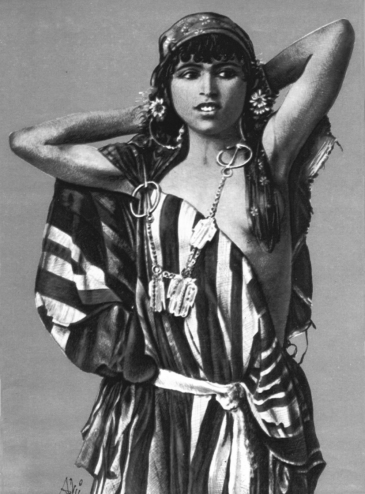Remove your veils!

It must have been a strange spectacle: a group of traditionally dressed female Muslims gathered on a stage. Then, before the eyes of the tense spectators and a specially invited group of international journalists, they were given a sign and simultaneously began to take off their veils. Perhaps they took to the podium one by one, pulled off their headscarves and publically declared that they were freeing themselves from patriarchal tradition and embracing emancipation.
Soldiers were ordered to mingle among the audience and encourage unveiled locals to join in, to support the de-veiling spectacle on the stage with applause and expressions of sympathy. Everything was carefully staged, no dramaturgical detail left to chance. But did Muslim women feel liberated from the male yoke in the wake of this public display?
The colonial rulers' masquerade
One of the women later recalled how she had cried when she was forced to put on a red and blue robe for the mass spectacle. As though in a theatre, she was supposed to embody "Marianne", the female representation of the French Republic.
Monique Ameziane was 18 years old when she was selected for the propaganda campaign of the French colonial power in Algeria, a campaign that attained its climax in de-veiling ceremonies held for maximum media effect in all the major towns and cities in the year 1958. Her story is documented in the military archives of the French army in Paris. The young Algerian woman did not voluntarily remove her veil, but only took part in the theatre because she was told that her detained brother might otherwise face execution. Others like her joined in because they did not want to lose their jobs in French households.
French generals intended to make an example of women like these, and show the whole world how modern France was triumphing over the archaic nations of Islamic Africa.

Step-by-step guides to de-veiling
In Egypt, the British had already realised by the late nineteenth century that women were the key to dominance of the colonies and instigated a public debate over the hijab. The feminist intellectual Leila Ahmed shows how Lord Cromer exploited the head covering to his own ends, in order to expose "Islam" as a complete social failure. He said that the gender-based segregation effected by the veil branded women as inferior and subservient to men. This was how Cromer attempted to play Egyptian women off against their husbands, fathers and brothers.
In order to put an end to the "medieval and barbaric customs of Islam", legions of well-meaning educators were let loose on the colonial civil population: missionaries, feminists, even doctors were deployed to express solidarity with repressed and disadvantaged women against the dominance of the Oriental male, and liberate them from it. They often distributed handbooks with a step-by-step guide on how to remove the veil.
Cromer – apparently such a champion of women's rights – made a name for himself in England as an opponent of female suffrage. In Egypt, he made sure that no more women qualified as doctors – women, he felt, were better able to realise their natural qualities as nurses. There are rumours that Cromer was not concerned with the freedom of Egyptian women at all, but that he couldn't bear to be seen by women concealed from his own view by the hijab.
The dream of a domesticated society
The colonial period in Egypt ended before the "forced emancipation" could bear real fruit. In Algeria, on the other hand, the dream of a total domestication of society continued for a while longer. But because most Muslim women did not want to give up their hijab of their own accord, they had to be pushed towards their "happiness", and because that wasn't as easy as they thought, the colonial authorities resorted to more creative methods.
Monique Ameziane, who had to play the part of "Marianne" in a de-veiling ceremony, is an example of this colonial inventiveness. The twist in her story is that in actual fact, until her stage appearance, she hadn't actually been wearing a headscarf at all. It was, in fact, wrapped around her head especially for the ceremony.

Frantz Fanon, who hailed from Martinique and was, therefore, himself from a French colony, is today regarded as a pioneer of post colonial theory. In his case studies from this era, Fanon presents other victims of the enforced de-veilings who were dressed in exotic traditional robes for the act – or at least in what the French considered to be traditional robes.
The media trick with the ethnic clothing had already been effective in the 1890s. At that time, pictures and postcards were circulated among the French public, allegedly portraying totally normal Muslim women as ladies of the harem in sumptuous robes and in suggestive poses, veiled yet bare-breasted. It later emerged that the pictures had been staged and that prostitutes had been paid a great deal of money for their involvement.
They did, however, fulfil their purpose and fuelled the oriental fantasies of French men, who were barred from all contact with Muslim women – apart from prostitutes. At the same time, those who remained at home could imagine that this was what conquest looked like. The Algerian author Malek Alloula has put together an informative collection of French harem pictures.
Colonial folklore for the anti-colonial resistance
But Fanon shows something else too – and this is the essential message that emerges from many of his writings, one that is considered far too infrequently in contemporary discourse – namely that women put up a fight. When they realised how obsessed the occupiers were with the veil and saw the possibilities that this presented, they wasted no time in exploiting the power of this piece of cloth to further their own interests. Female resistance fighters who had previously worn the veil now disguised themselves as converts by removing their headscarves. Dressed in Western outfits and high heels and with elaborately coiffed hair, they were not taken seriously by border guards patrolling France's newly acquired cities (such as Algiers). This enabled them to smuggle weapons for the anti-colonial resistance in their handbags.
These days, Muslim women in Europe are fighting back, but not in a militant fashion. Instead, they take their cases to the constitutional court or write books. At the same time, feminists such as Alice Schwarzer continue to take the same line as more than 100 years ago, namely that the key to the emancipation of Muslim societies lies in the status of women. They see the headscarf as the flag of Islamism; the symbol that sets women apart, that makes them second-class citizens. They say that the headscarf and full-body veil are a serious impediment to and restriction on movement and communication.
In all of this, they do not seem to be aware of the dilemma they are presenting to Muslim wearers of the headscarf: is the only option open to women to choose between allowing themselves to be dominated by men or by pseudo-feminists? Faced with this choice, many opt for the veil.
Susanne Kaiser
© Qantara.de 2015
Translated from the German by Nina Coon